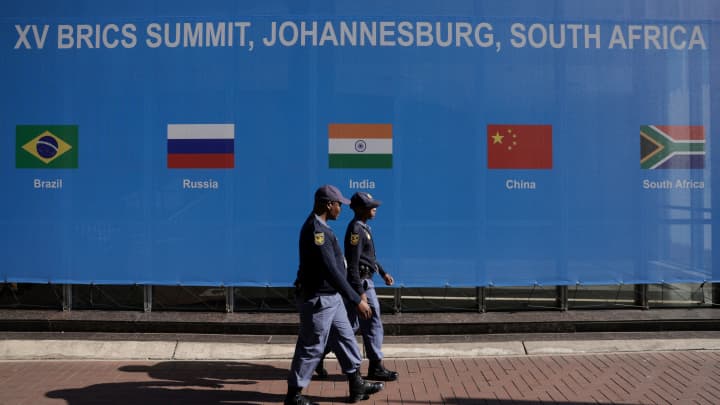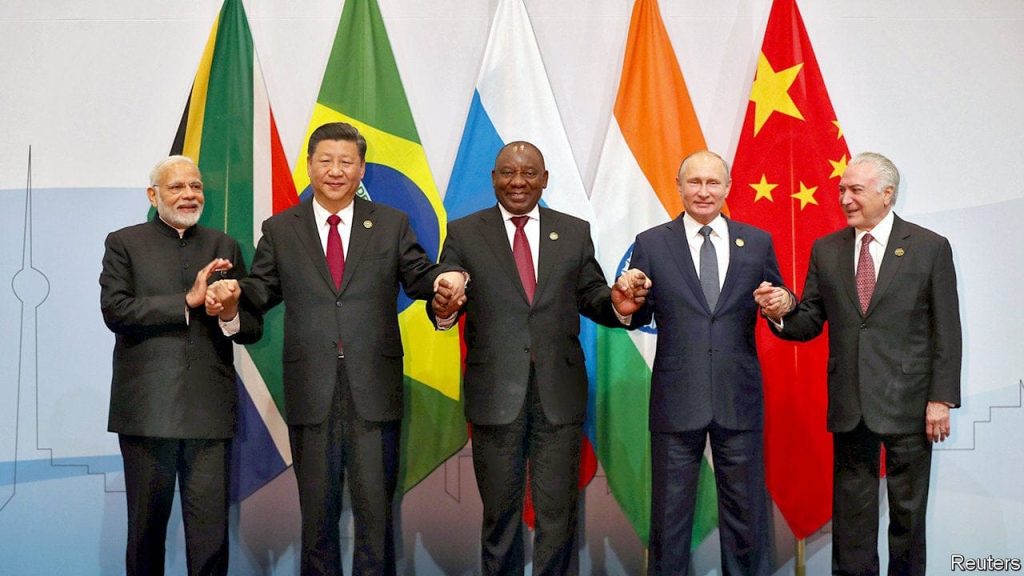A Gathering of Global Leaders Amidst Geopolitical Tensions
In the heart of Johannesburg’s bustling business district, leaders from Brazil, Russia, India, China, and South Africa gathered for the significant BRICS summit. This event aimed to discuss BRICS expansion and its role against Western powers but was eclipsed by Russia’s Ukraine invasion. President Putin, due to a war crimes warrant, addressed the summit remotely, making Ukraine the central topic.

The BRICS summit has historically been a platform for these emerging economies to forge diplomatic and economic bonds, challenging the dominance of Western-dominated alliances such as the Group of 7. However, with dozens of other countries seeking entry and influential players like Saudi Arabia, Indonesia, Egypt, and Argentina vying for inclusion, the dynamics within BRICS have become increasingly complex.

At the heart of BRICS’ economic agenda lies the New Development Bank, headquartered in Shanghai, which was established as an alternative to institutions like the World Bank, aiming to provide financing to developing nations. Additionally, discussions have revolved around the possibility of adopting a new currency to reduce the dollar’s prominence in international trade.
Yet, the five BRICS nations possess divergent interests, making consensus on these matters elusive. While Brazil, India, and South Africa have faced Western criticism for not condemning Russia’s actions in Ukraine, they remain keen on maintaining positive relations with both the United States and Europe, as well as with China and Russia.

China, a pivotal member of BRICS, surprisingly did not make an appearance at the summit’s opening session, despite engaging in a jovial state visit earlier in the day with South African President Cyril Ramaphosa. China’s commerce minister, Wang Wentao, delivered President Xi Jinping’s prepared speech, emphasizing that BRICS was not about taking sides or fostering bloc confrontations but rather expanding the architecture of peace and development.

The absence of President Xi from the larger meeting raised questions, with South African officials refraining from providing an explanation. Nonetheless, China’s growing influence in Africa and its efforts to strengthen ties outside Western-dominated structures like NATO, the Group of 7, and the European Union underscored its strategic importance within BRICS.
The India-China dynamic also played a significant role in the summit’s backdrop. India’s Prime Minister Narendra Modi expressed concerns about BRICS expansion, fearing the inclusion of nations closely aligned with Beijing. The historical border disputes and occasional military clashes between India and China have contributed to their cautious approach towards one another.

On a more optimistic note, BRICS offered a unique platform for Brazil’s former president, Luiz Inácio Lula da Silva, to advocate for strengthening the New Development Bank. Lula emphasized the shared burden of climate change faced by Brazil and Africa and called for collaborative efforts to combat its effects, asserting that such endeavors should not be dictated by major powers or existing international institutions.
Russian Foreign Minister Sergey V. Lavrov’s in-person attendance provided a brief diversion from the summit’s economic discussions. Lavrov’s enthusiastic participation in South African cultural traditions, such as joining a group of traditional dancers, demonstrated the diplomatic importance of the summit.
Within the context of trade and economics, the summit featured a parade of business leaders eager to transform BRICS into a formidable economic bloc. Diplomats and business forums hosted events on the sidelines, capitalizing on the summit’s global attention.
For South Africa, the smallest member of BRICS, hosting this international event was a significant achievement, boosting the nation’s morale amid domestic challenges. President Ramaphosa seized the opportunity to position himself as an international statesman and his country as a leading voice in Africa, inviting over 30 African heads of state to attend the summit. Some, like Egypt, expressed their desire to join the BRICS club.

However, the Ukraine conflict and its repercussions for global food supplies and prices dominated the summit’s agenda. Russia’s invasion led to a blockade of Ukrainian ports, causing a sharp decline in grain exports, which had far-reaching consequences for many developing countries, including some within BRICS.
In July 2022, the United Nations brokered an agreement that temporarily eased the crisis, allowing the safe passage of grain and food shipments to and from Ukraine. China emerged as the primary recipient of Ukrainian food exports during this period.
Regrettably, last month, President Putin withdrew from the agreement, citing inadequate provisions benefiting Russia. Subsequently, Russian forces initiated the systematic destruction of Ukrainian grain and port facilities. This decision, coupled with global supply chain challenges, put further pressure on international markets.
During his address at the summit, President Putin reiterated his claims that Western actions were responsible for the current world market crisis, offering to provide free food to impoverished nations. However, Russia’s record-high food exports during the agreement’s existence raised suspicions of Moscow exploiting hunger as both a weapon and a source of funding for the ongoing war.
President Ramaphosa, while maintaining a neutral stance on the Ukraine conflict, called for the resumption of the grain deal and the return of Ukrainian children taken by Russia, one of the charges against President Putin by the International Criminal Court.
How Will BRICS Affect the US Economy?

The BRICS alliance, comprising Brazil, Russia, India, China, and South Africa, holds the potential to impact the global economic landscape in various ways, some of which could have repercussions for the United States.
One potential effect of BRICS on the US economy is the possible decline in the dominance of the US dollar as a global reserve currency. Historically, the US dollar has held a prominent position in international trade and finance. However, BRICS countries, particularly China and Russia, have been exploring alternatives to the dollar for trade settlements and reserves. If successful, this shift could reduce the dollar’s influence in global financial markets, potentially affecting the dollar’s stability and the US’s ability to leverage its currency for economic advantages.

Moreover, the emergence of BRICS as a cohesive economic bloc could contribute to a more multipolar economic landscape. As these nations collaborate on economic initiatives, such as the New Development Bank and discussions around adopting a new currency, they could collectively challenge Western-dominated financial institutions and reshape the global economic order. This multipolarity could result in a more competitive environment for the United States in terms of economic influence and market access.
However, the impact of BRICS on the US economy is nuanced and not necessarily negative. While reduced US dollar dominance and a more multipolar economic landscape may pose challenges, they can also present opportunities. Increased trade prospects with BRICS nations could benefit US exporters and businesses, opening up new markets and avenues for economic growth.
The BRICS alliance has the potential to reshape the global economic landscape, with implications for the US economy. While challenges such as a potential decline in the dollar’s dominance exist, the emergence of a multipolar economic order could also offer opportunities for increased trade and economic cooperation. As BRICS continues to evolve, it will be essential for the United States to adapt and engage strategically to navigate this changing economic landscape.
Keep up with this story with Right Celebrity!